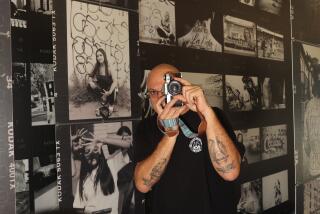The Mail-Order Gallery : A Ventura Magazine With Original Art on Every Page Is a Smash
Evelyn Jacob Jaffe usually displays her watercolors and collages in small Santa Barbara-area galleries and restaurants. Now they can also be seen in the Museum of Modern Art in New York, the Boston Museum of Fine Arts, the Museum of Contemporary Art in Los Angeles and a number of private collections.
The works aren’t yet hanging on walls of the big galleries, but they are showing up--as originals--in museum bookstores, art libraries and archives. How did Jaffe’s off-beat art emerge from obscurity?
The enviable exposure came through Art/Life, a bulky, hand-made Ventura-based magazine featuring original artworks and poetry by artists from as far away as Japan and Germany. In effect, the magazine is a mail-order art gallery in which each page of every issue is an original piece of art, including many that make creative use of materials such as chopsticks, Astroturf, dried herring, seaweed and even dirt.
Since it first appeared 10 years ago as a $3.50-an-issue newsletter, Art/Life has steadily grown to the point where it now distributes 200 issues 11 times a year. Overall, more than 1 million original artworks have appeared in the magazine, said Art/Life’s founder, Joe Cardella.
The magazine now retails for $50 an issue in museum stores and art bookstores, while its 35 subscribers pay $450 annually. It’s a lot pricier than most art magazines, but at 50 pages per issue, each art piece costs only $1, compared to about $50 each that the works might command if sold individually, Cardella said.
“It sells very well,” said Suzanne Sherman, who is in charge of buying magazines for the two stores in Los Angeles’ Museum of Contemporary Art (MOCA). “People say what a wonderful idea it is, how unique and beautiful it is.”
Cardella, a bearded, soft-spoken man with a passion for new ideas, graduated from Syracuse University with degrees in design and advertising. He served in the Navy as a communications specialist in the Mediterranean, and has worked off and on as an exhibit designer for museums in Syracuse, Oakland, Santa Barbara and Ventura.
Cardella, 45, said the concept for Art/Life seemed logical because it combined his experiences in art, advertising and communications. So he started the magazine with $500 in January, 1981, after leaving his job as a product developer at a Santa Barbara defense contractor. The goal was to start a magazine in which people could communicate ideas through art, he said.
Cardella’s magazine is “like belonging to a club of artists. It’s mail art,” said Jaffe, who co-owns a wholesale bagel company in Carpinteria when she’s not doing her watercolors and collages.
Contributing artists such as Jaffe each get a complimentary issue, leaving only 150 left over for subscribers and retailers. Those sales bring in less than $5,000 a month, so Cardella must cut costs by running the business out of his modest house in Ventura. He even does without a business phone number and supplements his income as a product-development and advertising consultant. “Mathematically, Art/Life can’t exist,” he said. “But it does.”
Contributors may spend days or weeks making the same piece of art 200 times over--one for each issue. Inevitably, there are minor variations among versions, but Cardella tells artists to strive for uniformity. It’s a painstaking task, but a small price for the chance to show their talents and ideas to other artists, dealers and museums.
Each month Cardella carefully arranges the 10,000 pages of original art into 200 8 1/2-by-11-inch transparent archival binders. His wife, Barbara Smeltzer, tries to make sure that the completed magazines get to their destinations. Last year, postage alone cost $6,000, Cardella said.
The bulk of submissions arrive from California and Germany, Cardella said. Sometimes, the paint is literally still wet when he opens the package. “It’s a rather archaic way of doing it,” Cardella said.
Art/Life has inspired several spinoffs, but only two, in Japan and Germany, survive, Cardella said. The magazine has also inspired several gallery exhibits.
About 80% of submitted works are accepted, he said. “Every artist would like to have their work recognized,” Cardella said. “That’s one of the primary reasons that Art/Life has succeeded. We put people’s art in places where they wouldn’t have access to.”
So far, the magazine has not brought overnight success to contributing artists. But regular contributors say their names and works are getting more recognition from fellow artists and some galleries. Most of all, they say, the magazine is a forum where artists can exchange ideas and express their creativity.
“If I have a lot of pieces out and each one has been seen by at least 200 people, then you have many thousands of people around the world that have seen my work,” said Mel Zaid, a Santa Barbara sculptor whose works have appeared in about 40 editions of Art/Life. “It’s an exposure that I just couldn’t get any other way.”
As is Jaffe, many contributors are part-time artists who view Art/Life as a creative break from their regular jobs. Others, such as Zaid, are professional artists attracted by the magazine’s emphasis on experimentation and freedom of expression.
“There’s no limit on content and technique,” said R. Anthony Askew, an art professor at Westmont College in Montecito whose work has appeared 18 times in Art/Life. “You have a wonderful opportunity to create art that you wouldn’t normally do anywhere else.”
More to Read
The biggest entertainment stories
Get our big stories about Hollywood, film, television, music, arts, culture and more right in your inbox as soon as they publish.
You may occasionally receive promotional content from the Los Angeles Times.










